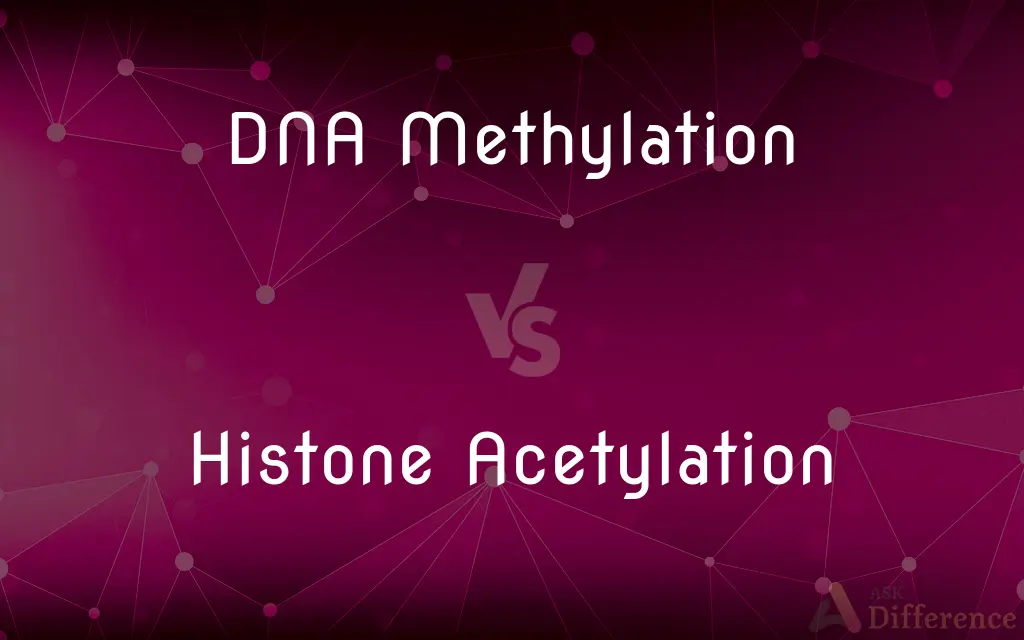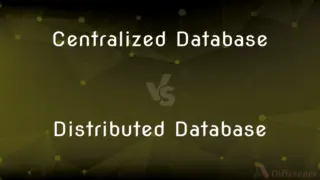DNA Methylation vs. Histone Acetylation — What's the Difference?
By Tayyaba Rehman — Published on November 2, 2023
DNA methylation involves adding a methyl group to DNA, often silencing gene expression, while histone acetylation involves adding an acetyl group to histones, typically promoting gene expression.

Difference Between DNA Methylation and Histone Acetylation
Table of Contents
ADVERTISEMENT
Key Differences
DNA Methylation and Histone Acetylation are both post-translational modifications that influence gene expression. DNA Methylation involves the addition of a methyl group to the cytosine base in DNA. This process typically represses gene transcription, meaning that genes are less likely to be expressed when they are methylated. On the other hand, Histone Acetylation refers to the addition of an acetyl group to histone proteins that DNA wraps around. Unlike DNA methylation, histone acetylation usually promotes gene expression by making the DNA more accessible to the transcriptional machinery.
Both DNA Methylation and Histone Acetylation play critical roles in various cellular processes. While DNA Methylation often silences genes and is crucial for processes like genomic imprinting and X-chromosome inactivation, Histone Acetylation makes DNA more open, facilitating processes like transcription, DNA repair, and DNA replication. The two processes can also interplay; certain methylation patterns on DNA can influence the acetylation patterns on histones and vice versa.
It's essential to understand that both DNA Methylation and Histone Acetylation are reversible processes. Enzymes can add or remove these modifications as needed. While enzymes known as DNA methyltransferases facilitate DNA Methylation, histone acetyltransferases (HATs) add acetyl groups during Histone Acetylation. Conversely, DNA demethylases remove methyl groups, and histone deacetylases (HDACs) remove acetyl groups.
In the context of disease and therapeutics, understanding DNA Methylation and Histone Acetylation is crucial. Abnormal patterns of DNA Methylation can lead to inappropriate gene silencing, seen in diseases like cancer. Similarly, irregular Histone Acetylation can also contribute to various diseases. Because of their significance, many drugs aim to target enzymes responsible for these modifications to treat diseases.
Comparison Chart
Function
Adds a methyl group to DNA
Adds an acetyl group to histones
ADVERTISEMENT
Effect on Gene Expression
Typically repressive
Typically promotive
Reversibility
Reversible, enzymes can add or remove the modification
Reversible, enzymes can add or remove the modification
Associated Enzymes
DNA methyltransferases and DNA demethylases
Histone acetyltransferases (HATs) and histone deacetylases (HDACs)
Role in Disease
Abnormal methylation can cause gene silencing, prevalent in cancers
Abnormal acetylation can affect gene expression, linked to diseases like cancer
Compare with Definitions
DNA Methylation
Involves modification of the cytosine base.
During DNA Methylation, the cytosine base is targeted.
Histone Acetylation
Involves enzymes like HATs and HDACs.
HATs add acetyl groups during Histone Acetylation.
DNA Methylation
Plays a role in genomic imprinting.
Genomic imprinting relies on patterns of DNA Methylation.
Histone Acetylation
Usually promotes gene expression.
Genes are more likely to be transcribed after Histone Acetylation.
DNA Methylation
Often leads to gene repression.
Increased DNA Methylation in a gene region often reduces its expression.
Histone Acetylation
Can influence cellular memory and differentiation.
Histone Acetylation patterns can guide cell differentiation pathways.
DNA Methylation
A biochemical process adding a methyl group to DNA.
DNA Methylation can silence certain genes.
Histone Acetylation
A process where acetyl groups are added to histone proteins.
Histone Acetylation makes the DNA more accessible.
DNA Methylation
Implicated in various diseases like cancer.
Abnormal DNA Methylation patterns are seen in many cancers.
Histone Acetylation
Changes the charge of histone proteins.
By acetylating histones, their charge is modified, loosening their grip on DNA.
Common Curiosities
How does Histone Acetylation influence genes?
Histone Acetylation adds an acetyl group to histones, typically promoting gene expression by making DNA more accessible.
Are both modifications reversible?
Yes, both DNA Methylation and Histone Acetylation are reversible.
Which process is typically associated with gene silencing?
DNA Methylation is often linked to gene silencing.
What happens to the DNA when it's methylated?
When DNA is methylated, it often becomes less accessible, leading to reduced gene expression.
Can DNA Methylation and Histone Acetylation interplay?
Yes, methylation patterns on DNA can influence acetylation patterns on histones and vice versa.
What enzymes facilitate Histone Acetylation?
Histone acetyltransferases (HATs) add acetyl groups during Histone Acetylation.
Why is understanding these modifications crucial in medicine?
Abnormal patterns in DNA Methylation or Histone Acetylation can lead to diseases, so targeting these processes can offer therapeutic strategies.
How do cells remember their identity during division?
Patterns of DNA Methylation and Histone Acetylation can help retain cellular memory during division.
How do histones change during acetylation?
During acetylation, histones gain acetyl groups, changing their charge and loosening their interaction with DNA.
What is DNA Methylation?
DNA Methylation is the addition of a methyl group to the cytosine base in DNA, often repressing gene expression.
Can changes in these processes lead to cancer?
Yes, abnormal DNA Methylation and Histone Acetylation patterns can contribute to cancer development.
Which process, methylation or acetylation, is linked to DNA accessibility?
Histone Acetylation is more directly linked to increased DNA accessibility.
What role does DNA Methylation play in development?
DNA Methylation is essential for processes like genomic imprinting and X-chromosome inactivation in development.
Which enzymes reverse DNA Methylation?
DNA demethylases can remove methyl groups from DNA.
What's the impact of removing acetyl groups from histones?
Removing acetyl groups, a process involving histone deacetylases (HDACs), typically makes DNA less accessible, repressing gene expression.
Share Your Discovery

Previous Comparison
Nylon Jacket vs. Polyester Jacket
Next Comparison
Centralized Database vs. Distributed DatabaseAuthor Spotlight
Written by
Tayyaba RehmanTayyaba Rehman is a distinguished writer, currently serving as a primary contributor to askdifference.com. As a researcher in semantics and etymology, Tayyaba's passion for the complexity of languages and their distinctions has found a perfect home on the platform. Tayyaba delves into the intricacies of language, distinguishing between commonly confused words and phrases, thereby providing clarity for readers worldwide.












































